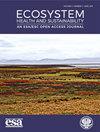微塑料能否介导陆地生态系统中的土壤特性、植物生长和碳/氮周转?
IF 3.4
2区 环境科学与生态学
Q1 ECOLOGY
引用次数: 3
摘要
摘要微塑料污染是一个全球性的环境问题,近年来在海洋和淡水环境中得到了研究。然而,我们对MP对陆地生态系统的影响,特别是碳(C)和氮(N)周转的理解仍然很差。本文综述了陆地生态系统中MPs的来源和分布特征,并探讨了它们对土壤性质、植物生长、碳氮周转的影响。一旦进入陆地生态系统,MPs可以通过改变土壤特性(如pH、土壤团聚体稳定性和土壤孔隙度)来吸收碳和氮。MPs可以直接影响植物或土壤物理环境和微生物代谢环境,间接影响植物生长,从而通过植物枯枝落叶和根系的变化改变土壤C和N输入的数量和质量。MP污染引起的优势菌门、相关功能基因和酶的变化可能影响C和N循环。此外,MP效应随其性质(例如,类型、形状、元素组成、官能团、释放的添加剂)而变化。未来的研究应该统一MP分离、检测的标准体系,并揭示MP的生态效应,特别是在气候变化的背景下对陆地碳氮循环的影响。本文章由计算机程序翻译,如有差异,请以英文原文为准。
Can microplastics mediate soil properties, plant growth and carbon/nitrogen turnover in the terrestrial ecosystem?
ABSTRACT Microplastic (MP) pollution, a global environmental problem, has been recently studied in marine and freshwater environments. However, our understanding of MP effect on terrestrial ecosystems, especially carbon (C) and nitrogen (N) turnover remains poor. This review summarizes the sources and distribution characteristics of MPs in terrestrial ecosystems and explores their effects on soil properties, plant growth, C and N turnover. Once entering the terrestrial ecosystem, MPs could involve in sequestrating carbon and nitrogen by changing soil properties (e.g., pH, soil aggregate stability, and soil porosity). MPs could exert direct influences on plants or on soil physical environment and microbial metabolic environment to indirectly affect plant growth, thus altering the quantity and quality of soil C and N inputs by shifts in plant litter and roots. The changes of the dominant bacteria phyla, related functional genes, and enzymes caused by MP pollution could affect C and N cycles. Additionally, the MP effect varies with its properties (e.g., types, shapes, elemental composition, functional groups, released additives). Future researches should unify the standard system of MP separation, detection, and reveal the ecological effects of MPs, especially their impacts on terrestrial carbon and nitrogen cycles in the context of climate changes.
求助全文
通过发布文献求助,成功后即可免费获取论文全文。
去求助
来源期刊

Ecosystem Health and Sustainability
Environmental Science-Management, Monitoring, Policy and Law
CiteScore
7.10
自引率
2.00%
发文量
40
审稿时长
22 weeks
期刊介绍:
Ecosystem Health and Sustainability publishes articles on advances in ecology and sustainability science, how global environmental change affects ecosystem health, how changes in human activities affect ecosystem conditions, and system-based approaches for applying ecological science in decision-making to promote sustainable development. Papers focus on applying ecological theory, principles, and concepts to support sustainable development, especially in regions undergoing rapid environmental change. Papers on multi-scale, integrative, and interdisciplinary studies, and on international collaborations between scientists from industrialized and industrializing countries are especially welcome.
Suitable topics for EHS include:
• Global, regional and local studies of international significance
• Impact of global or regional environmental change on natural ecosystems
• Interdisciplinary research involving integration of natural, social, and behavioral sciences
• Science and policy that promote the use of ecological sciences in decision making
• Novel or multidisciplinary approaches for solving complex ecological problems
• Multi-scale and long-term observations of ecosystem evolution
• Development of novel systems approaches or modeling and simulation techniques
• Rapid responses to emerging ecological issues.
 求助内容:
求助内容: 应助结果提醒方式:
应助结果提醒方式:


